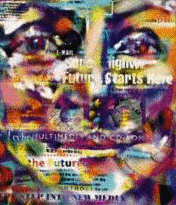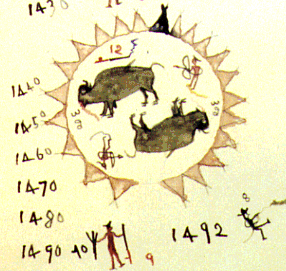The Shape of Stories: Digital Storytelling, Hypertext Poetry, and New Multimedia Expressions
Questions & Activities
WEB/TEXT Connections
 This
thematic platform provides a rich set of links to resources on alternative
forms of storytelling, especially hypertext fiction and digital storytelling.
Within this platform there are some connections made to Native American
storytelling, and other oral and visual storytelling cultural traditions
(such as Chicano Murals) that represent non-linear, non-textual ways of
telling stories. In short, the theme of this thematic platform revolves
around ways to think of stories apart from traditional print narrative.
This
thematic platform provides a rich set of links to resources on alternative
forms of storytelling, especially hypertext fiction and digital storytelling.
Within this platform there are some connections made to Native American
storytelling, and other oral and visual storytelling cultural traditions
(such as Chicano Murals) that represent non-linear, non-textual ways of
telling stories. In short, the theme of this thematic platform revolves
around ways to think of stories apart from traditional print narrative.
One reason for thinking about new Web-based
narrative forms, in the context of other older or non-European narrative
traditions is to remember to what extent certain forms or writing which
we may think of as natural or inevitable are really conditioned
by culture. 
This is important to keep in mind when reading any of the examples of hypertext fiction (non linear and multi-linear narrative) linked from this platform. Hypertext writing (fiction or poetry) is possible only in an electronic environment. Below there are links to numerous sites which will explain what hypertext fiction and hypertext poetry is. There are also sites that tell stories through multimedia and "mixed media."
Hypertext writing shares some interesting features with, for example, Native American storytelling traditions: there is a digressive element (stories within stories); what is called "a story" is really a Web of stories, and like oral tellings, in hypertext, no two tellings of a hypertext narrative are exactly the same for readers. Naturally there are other key differences that make them disimilar as well. In hypertext fiction the focus is on the reader and the appearance of choice and some determination of how to read, as every part of a hypertext narrative presents multiple choices for the direction and sequence of reading.
What you'll find below are questions and links looking at hypertext fiction, poetry, and other multimedia stories and artistic and critical expressions, some of which resist any particular genre of writing we have a name for now.
If you know of a resource you think should be added to this page, please write and we'll try to add it.
[Images: "New Media," by
Jeremy Sutton, and Winter Count Calender, Battiste Good, Sichangu
nation]